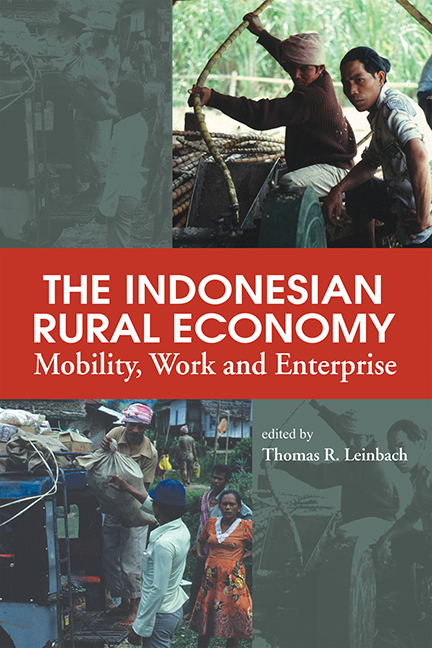Book contents
- Frontmatter
- Content
- List of Tables
- List of Figures
- Contributors
- Acknowledgements
- Glossary
- Foreword
- Part I The Development Context
- Part II Entrepreneurship, Gender and Mobility Issues
- Part III Indonesia's Rural Non-Farm Economy: Case Studies and Policy Development
- Chapter 9 Small Enterprises, Fungibility and South Sumatran Transmigration Livelihood Strategies
- Chapter 10 Transitions to Non-Farm Employment and the Growth of the Rattan Industry: The Example of Desa Buyut, Cirebon
- Chapter 11 Policy Implications for RNFEs: Lessons from the PARUL Project in Indonesia
- Chapter 12 The Indonesian Rural Economy: Insights and Prospects
- Index
Chapter 11 - Policy Implications for RNFEs: Lessons from the PARUL Project in Indonesia
from Part III - Indonesia's Rural Non-Farm Economy: Case Studies and Policy Development
Published online by Cambridge University Press: 21 October 2015
- Frontmatter
- Content
- List of Tables
- List of Figures
- Contributors
- Acknowledgements
- Glossary
- Foreword
- Part I The Development Context
- Part II Entrepreneurship, Gender and Mobility Issues
- Part III Indonesia's Rural Non-Farm Economy: Case Studies and Policy Development
- Chapter 9 Small Enterprises, Fungibility and South Sumatran Transmigration Livelihood Strategies
- Chapter 10 Transitions to Non-Farm Employment and the Growth of the Rattan Industry: The Example of Desa Buyut, Cirebon
- Chapter 11 Policy Implications for RNFEs: Lessons from the PARUL Project in Indonesia
- Chapter 12 The Indonesian Rural Economy: Insights and Prospects
- Index
Summary
Introduction
While rural non-farm enterprises (RNFEs) have long been of interest to researchers and academics, they present something of a puzzle to planners and policy makers. As this book amply testifies, researchers have found that RNFEs provide an illuminating indicator of changes taking place in rural society. The nature of goods and services produced by rural enterprises may reflect the extent of technological transformation and the degree of interaction between rural and urban markets. Their growth or decline may be seen as a measure of the impact of globalization on the rural economy and adaptation to it. The importance of RNFEs as a source of income for farm households may reveal the extent to which they are gradually becoming less dependent on agriculture and more involved in the modernizing mainstream economy.
Planners and policy makers, however, are often at a loss in knowing what to make of RNFEs and determining an appropriate policy response. Do they represent a sufficiently important part of the economy to warrant attention? Should scarce public resources be devoted to them rather than other urgent priorities? Are they likely to generate a worthwhile return on investment?
Sceptics may be inclined to answer ‘no’. RNFEs are commonly perceived as micro scale operations, peripheral to agriculture and other core industries, providing only incidental employment and marginal extra income for rural households. Production methods are primitive, the quality of goods is low, and it is only a matter of time before these enterprises are swept away by larger firms using more advanced technology to produce cheaper and better goods. In sum, public investment would be largely wasted and can be used for better purposes.
These perceptions, however, are wide off the mark. It may be true that national policies for foreign investment and the decisions of multi-national corporations to come or go make big news and big impacts where they are located. It is equally true that the numerous dispersed small-scale activities of rural non-farm entrepreneurs go unsung and largely unrecorded. But while it may be difficult to measure their collective contribution to the local economy, we should not assume that it is insignificant or unimportant.
As discussed in other chapters in this book, the role played by RNFEs is often far greater than is commonly appreciated (see also Rondinelli 1993).
- Type
- Chapter
- Information
- The Indonesian Rural EconomyMobility, Work and Enterprise, pp. 267 - 292Publisher: ISEAS–Yusof Ishak InstitutePrint publication year: 2003

